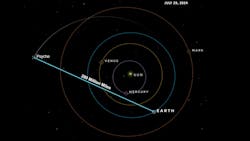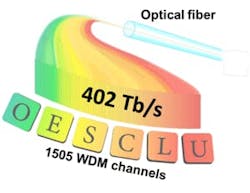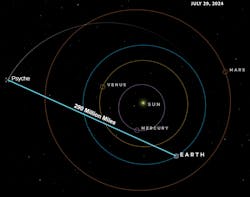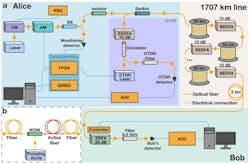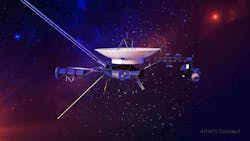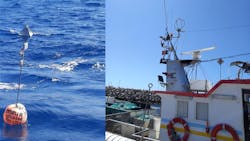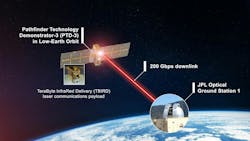Electronic World Records: Communication Technologies
What you’ll learn:
- Longest Laser Transmission
- Quantum Transmission Distance
- Daily New Record for Longest Distance
- Longest Wi-Fi Transmission
- Longest LoRaWAN Transmission
- Largest Wireless Data Speeds
- Fastest Earth to Orbiting Satellite Data Transmission
- Fastest Optical-Chip-Based Data Speeds
There's a cottage industry of world-record attempters—people or institutions who completely focus their lives on world records. Take the film King of Kong for example. It features a few people who want to beat the original King Kong arcade machine in the fastest time. More obscure being the longest skateboard ride for a cat, cycling backwards with a violin, and the number of snails on a face. You even have Ashrita "Mr. Versatility" Furman, who is the person with the most world records to his name—over 700 at the moment.
Those are fun novelties, peaking curiosities. However, some world records showcase the peak of human achievement, and I'm talking about the world of electronics. In an ongoing series of articles, I hope to shed light on many of those accomplishments. The intent is to inspire, educate, and (perhaps) surprise people with what we as engineers have accomplished.
In the first such showcase, I want to look at communications in both the terrestrial and extraterrestrial (and not the Roswell type).
Highest Bandwidth
Aston University and the National Institute of Information and Communications Technology (NICT) set a record for highest data throughput. In June 2024, the team transmitted data over a 31-mile fiber-optic network, reaching speeds of 402 Tb/s. This covered a bandwidth of 37.6 THz (1,281.2 nm to 1,649.9 nm), using all transmission bands (OESCLU) of the low-loss window of standard optical fibers.
NICT's system deployed advanced amplification technology and a wideband dense wavelength-division multiplexing (DWDM) signal with up to 1,505 channels. To achieve high data rates, they used dual-polarization quadrature-amplitude modulation (DP-QAM) with up to 256 symbols per constellation.
Longest Laser Transmission
On July 29, 2024, NASA also set a record for longest-distance laser communication. Its Deep Space Optical Communication (DSOC) technology transmitted a laser signal from the Earth to the Psyche spacecraft—290 million miles away. However, this occurred at low speeds due to signal loss from traveling long distances. It maintained a downlink of 6.25 Mb/s and a peak of 8.3 Mb/s while transmitting a laser signal over 240 million miles on June 24, 2024.
Quantum Transmission Distance
Terra Quantum holds the world record for the longest quantum key distribution (QKD) over 1,060 miles. The company didn't mention how many quantum keys were transmitted over a long distance. They used standard optical fiber and optical amplifiers leveraging multi-photon states along the transmission lines, boosting the signal over long distances. Terra Quantum also deploys quantum decryption and encoding hardware at the sender and receiver sites. This technique is compatible with existing telecommunication infrastructure as it doesn't require special quantum repeaters.
This surpasses Terra Quantum's previous record of 1,032 km using fiber-optic cables in 2023. At that time, the company transmitted data at speeds of 34 bits per second, beating the previous record of 0.0034 bits per second.
Daily New Record for Longest Distance
Both Voyager probes are still traveling through space, setting new records for the longest communication distance. The signals take 22.5 hours to reach Voyager 1 as the probe is 167.34 AU (15.6 billion miles) away from Earth. Meanwhile, Voyager 2 is 140.32 AU (13.0 billion miles) from Earth. Signals take 18.5 hours to reach the probe.
Longest Wi-Fi Transmission
In 2007, Ermanno Pietrosemli set a record for the longest Wi-Fi signal transmission using the 802.11 standard. It traveled 237 miles between two mountains in Venezuela and reached a throughput of 3 Mb/s during that transmission.
In February 2025, Morse Micro set a record with HaLow technology, transmitting signals over 10 miles in Joshua Tree National Park at 2 Mb/s. The company used an MM6108-EKH01 evaluation kit featuring a Raspberry Pi 4 with an MM6108-MF08651 Wi-Fi HaLow reference module. This kit outputs 21 dBm through a 1 dBi low-gain dipole antenna.
Longest LoRaWAN Transmission
In September 2023, the longest distance for a LoRaWAN message transmission was set at 830 miles as part of the Custodian project. LoRaWAN STEVAL-STRKT01 trackers from STMicroelectronics were placed on a fishing boat, and buoys off the Sesimbra coast sent messages to a gateway in the Canary Islands. They performed this experiment at sea level to reduce altitude-related variables.
Largest Wireless Data Speeds
In October 2024, UCL engineers set a new record for wireless data-transmission speed, achieving 938 Gb/s. By combining high-speed electronics with millimeter-wave photonics, their system transmitted data across an unprecedented frequency range of 5 to 150 GHz, significantly extending beyond standard wireless systems. This breakthrough boosts bandwidth, reduces congestion, and enables faster, more reliable wireless networks.
Fastest Earth to Orbiting Satellite Data Transmission
NASA's TBIRD (TeraByte InfraRed Delivery), aboard the Pathfinder Technology Demonstrator-3 (PTD-3), holds the record for the fastest data transmission from an earth-orbiting satellite to a ground-based station.
In June 2023, TBIRD downlinked 4.8 TB of error-free data in five minutes on a 200-Gb/s data downlink. The system uses infrared laser light for data transmission and features a specialized version of an automatic repeat-request (ARQ) protocol for error-free laser communications through the atmosphere. This is a significant achievement as it provides data rates 100X faster than the best internet on Earth and 1,000X faster than radio-frequency links for satellite communications.
Fastest Optical-Chip-Based Data Speeds
In 2020, researchers from Monash, Swinburne, and RMIT Universities used an optical chip to achieve the fastest internet data speed, reaching 44.2 Tb/s. Rather than a laboratory, the team load-tested the network in a real-world communications infrastructure.
For the first time, they installed a microcomb—a substitute device for 80 lasers—within 47.59 miles of dark optical fibers between RMIT's Melbourne City Campus and Monash University's Clayton Campus. The microcomb acts like a rainbow made of hundreds of high-quality infrared lasers. One laser functions as an independent communications channel. The team transmitted peak data through a single channel, replicating maximum internet traffic across 4 THz of bandwidth.
Did you know of all these achievements? Sound off in the comments below.
Know a few more I missed? Sound off in the comments below.
Is this the longest request you’ve read asking for comments? Sound off in the comments below.
About the Author
Cabe Atwell
Technology Editor, Electronic Design
Cabe is a Technology Editor for Electronic Design.
Engineer, Machinist, Maker, Writer. A graduate Electrical Engineer actively plying his expertise in the industry and at his company, Gunhead. When not designing/building, he creates a steady torrent of projects and content in the media world. Many of his projects and articles are online at element14 & SolidSmack, industry-focused work at EETimes & EDN, and offbeat articles at Make Magazine. Currently, you can find him hosting webinars and contributing to Electronic Design and Machine Design.
Cabe is an electrical engineer, design consultant and author with 25 years’ experience. His most recent book is “Essential 555 IC: Design, Configure, and Create Clever Circuits”
Cabe writes the Engineering on Friday blog on Electronic Design.
